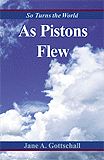
Taken from the book with permission "As Pistons Flew" by Jane A. Gottschall
www.Xlibris.com/AsPistonsFlew.html from there you can click on the excerpt
and to the other www.Xlibris.com/JaneAGottschall.html

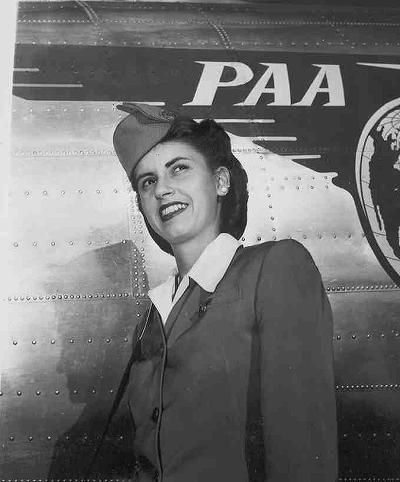
As Pistons Flew
So Turns the World
by Jane A. Gottschall
Chapter 1
"It's a DC-3! It's got to be. Hear it? Hear it?" As if all in the world were listening, when no one was around.
The screen door slammed shut and locked as I ran down the steps of my family home. I had been resting on the porch glider when disturbed by a distant drone that triggered an impulse to rise and take notice. I looked toward what little sky could be seen between oak tree branches, but I saw no aircraft. I only heard an engine hum that had awakened memories and a tight feeling in my heart.
"It had to be a DC-3. I'd know it anywhere," I said to myself. Digging a key out of a fern pot, I unlocked the screen door, lay upon the glider again to drift back in time.
Most airlines called the DC-3 the "old Douglas workhorse", the reliability of which kept the owners in business. Without pressurization or apt sound proofing, it flew low and slow compared to larger planes to come. From its windows one seldom looked upon a flat, hazy, distant surface to the world. Instead, earth's features could be seen-curves of mountains, colors of lakes, cars moving on roads, ocean waves crashing upon shores, and cloud formations as a sea of popcorn and powder puffs. Pilots liked the DC-3 for its proficiency and ease, giving them a "hands on wheel" feel to flying, with instruments used as an aid rather than a control. The DC-3 was so dependable; pilots swore it could land on a postage stamp. I might almost believe it from my own experience.
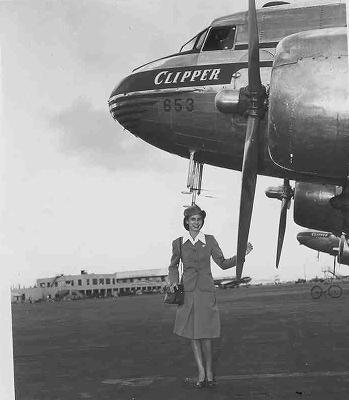
It happened back in 1945 when I was a new stewardess flying over Guatemala. The DC-3 held a complement of 21 passengers, three cockpit crew, and one cabin attendant. We left Merida, Mexico, in the Yucatan Peninsula, after connecting via the Boeing-307 flown down from New Orleans. The flight was scheduled to Panama, making several stops in Central America. We left New Orleans at night and Merida in the darkness of early morning, as all flights to Panama had to arrive before sunset. No commercial aircraft could fly over Panama at night, to protect the Canal. World War II was not over.
I was on my own as stewardess for the DC-3, an airplane with two engines, and all mine from the cockpit door to the aft galley. Ours was the only plane at the ramp after the Boeing departed to return to New Orleans. Seldom were there more. A crowd of people in a festive mood remained. Their jollity measured up to the exciting fresco paintings on the walls. Mariachi musicians were shaking bead gourds in rhythmic motion, so familiar to Mexico, and elevated the sound at the time of departure.
The DC-3 had no public address system; an electric bell was used for communication from cockpit to cabin. One bell indicated the steward/ess should assure that seat belts were fastened and no cigarettes were lighted. Two bells were for the attendant to be seated. If three bells were sounded it usually meant the steward/ess must come to the cockpit "muy pronto." The latter could mean we left a passenger or cargo on the tarmac or, what was most unwanted, an R-E-M (return due maintenance), which could be anything from a sudden drop in oil pressure to just a panel light bulb needed.
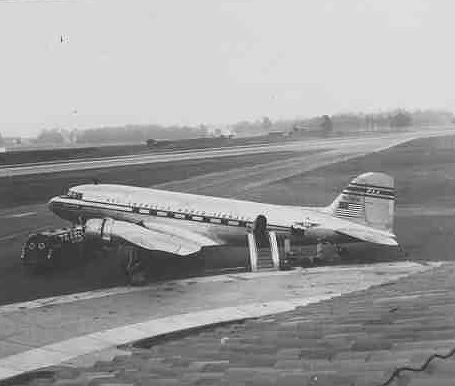
Everything was satisfactory as the co-pilot read the checklist. The engines were put to takeoff power, brakes released, and away we went. Normally it took only a minute or two after leaving the "blocks" before becoming airborne.
After the last breakfast trays were served, a passenger stopped me in the aisle and pointed to the starboard engine, saying, "Why aren't those propellers moving?" I glanced out the window and saw three blades, silent and still. It was the first time I had ever seen a "feathered engine," and there was no cockpit call.
Only months before I had walked into the sales office of Pan American Airways in New Orleans, answering an ad for reservation clerks. With WWII still going on, women were better able to obtain work. The closest I had come to any airplane affiliation was summer employment at Higgins Aircraft, a war plant in Louisiana, which never produced one plane. The factory only existed in case any fully productive plant was bombed. (Nearby, Higgins built the famous P-T boats used so successfully in the war.) I had worked in the blueprint department making good money for a teenager, with the title of Draftsman-2, when all I did was make diagrams legible. The idea of traveling had long appealed to me, since working in my college library and getting lost in the National Geographic magazine racks. At least the reservations office of an airline had seemed a closer step. There was great excitement in being associated with Pan American Airways. The airline promoted passenger and freight service abroad, sponsored construction of airports, runways, even overnight accommodations, and assisted the U.S. government in equipment and troop transport for our armed forces even into battle areas. I got the job and felt proud in just being a part of "PanAm".
After envisioning glamorous places against four walls and a Teletype, I hungered to accompany the passengers. Opportunity arose when recruiters came to the office to interview stewardess applicants. (Up until that year [1944], PanAm had only hired men as crew.) Before the recruiters were to leave, I had gathered the courage to announce a final applicant. When asked to show her in, I replied, "She is I." However, there was one qualification about which I had great trepidation-to have a fair speaking knowledge of Spanish, as this was the Latin American Division of the airline. I had studied Spanish in college, could read it fairly well, but to comprehend as spoken was a struggle. Brushing up on my textbooks, I decided to memorize a few expressions and gamble on that I might be asked the same questions that I had overheard. The plan worked. My pronunciation must have sounded fair, though I knew I had not fooled the handsome male recruiter. Later I learned I had been accepted, subject to passing a physical examination.
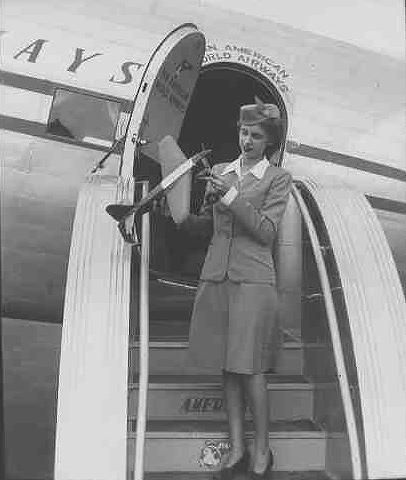
Going to Miami for six weeks of training was by way of a company ferry flight from New Orleans. All aboard had to be employees, as government regulations prohibited PanAm from carrying any revenue passengers from one U. S. stop to another. PanAm had no domestic flights, but when an airplane was due for primary maintenance check, it was ferried to Miami. This flight on the Boeing-307 was my first on any airliner.
I found living quarters with girls who were already flying. I listened to their talk and envied them, even when they would return and say, "I'm pooped!" Being fitted for uniforms was a highlight-powder blue in color, a skirt with a front kick pleat, a collarless jacket, a long-sleeve, white blouse with pointed lapels. The hat was like a bowl with a stiff front, holding a side wing tip for the company emblem, picturing North and South America on a blue globe. My roommates introduced me to PanAm and military friends with whom we shared good times. When the orchestra at the Coral Gables Country Club played "it might as well be spring", it was the springtime of my life.
On this day, I opened the cockpit door and asked a very calm appearing pilot, "Captain Cornwell, that motor out there on the right side, I mean 'engine', that has stopped-what should I tell the passengers?"
"Oh, there you are. Sorry not to 'beep' you sooner but we've been a little busy up here. It's okay now. We're just going to let that 'motor' rest awhile," he replied. The co-pilot grinned, as both men knew I was new at the job. The captain started to say, "tell the passengers-", but was interrupted when suddenly the port side, and only other engine, began to sputter. Rarely were both engines in trouble at the same time. Quick movements came with the captain's commands, responses from his co-pilot, and the radio operator clicking SOS by Morse code. There was no aircraft-to-ground telephone contact at that time, unless close to an airport.
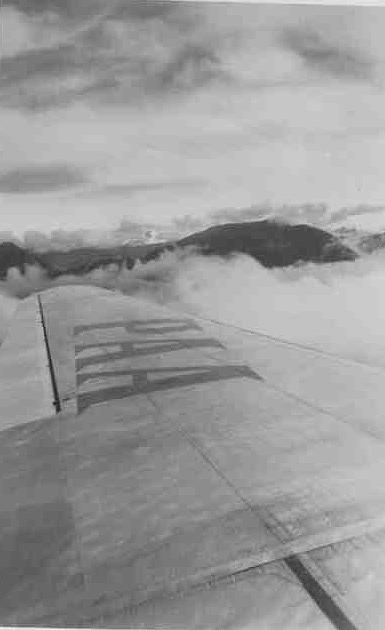
As I backed out of the cockpit with a "Secure the Cabin" order, I was assured that the plane would land in La Libertad, a small clearing in the Peten jungles of Guatemala, about 15 minutes away. In the cabin I looked up to see 21 faces with the most pathetic expressions. Like anticipating children, they waited for me to speak. I looked toward the passenger who had first alerted me and saw that the starboard engine props were spinning again. "Ah," I said aloud with relief, "it's all right now." Then I heard, "Well, why's the other engine feathered?"
The remark embarrassed me to think how this was MY airplane. It HAD to recover. I walked down the aisle telling everyone that we would land in "La Libertad", as though it was a familiar place. One passenger was a young boy traveling alone; another, a U.S. senator who remained silent. Some passengers asked what was wrong; seasoned flyers pretended not to be disturbed. As I had to insist upon picking up unfinished meal trays and storing loose objects, the problem sounded serious. When we began to lose altitude, affecting pressure in our ears, it became eminently more serious. The fast descent made walking the aisle feel as though heavy weights were carried on each foot. There was no doubt-we were falling! I could barely lift my body after securing low latches, such was the force from a rapid descent.
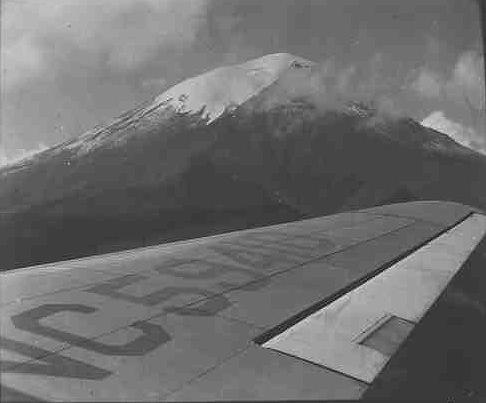
Fifteen seconds is a short period, unless you are witnessing an earthquake. Fifteen minutes in an aircraft with both engines barking spits and threats, can be an eternity. The pilots had turned the engines on and off alternately to gather as much power as could be mustered. Activating a sick engine can cause its complete demise, like a car's wheel rim when driving on a flat tire; however, the choice is not healthy either. Years later, when asked about this flight, I would say I was too young to be really frightened, and too busy to think of fear. Something about youth makes you believe that death is not today, nor tomorrow; maybe when you are old, but never today. I had yet to see my 21st birthday.
Though no passenger required a sick bag, one aspect came up too quickly-the sight of the approaching Peten jungles. The earth appeared to be coming to us, not our going to it. I saw no clearing. Where was this La Libertad? I pressed my hand to the shoulder of the young boy-but to him it all seemed a thrill. Fear came upon even the courageous when suddenly there was no sound outside, not even the wind. Both engines were extinguished. We were floating down.
Almost as I got seated and called out, "We'll make it, okay," there was the thump of wheels to earth; a landing for any pilot to be proud of and for the DC-3 to prove its worth. The plane lightly bounced over a grassy field, rolled to the end of the area and braked to a halt, abruptly but safely. As pilots will say-any landing you can walk away from is a good landing.
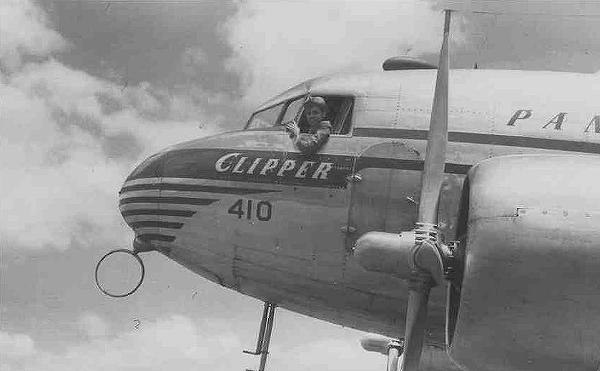
TRIBUTE TO THE DC-3
In fifty-one they tried to ground the noble DC-3
And some lawyers brought the case before the C.A.B.
The board examined all the facts behind their great oak portal
And pronounced these simple words “The Gooney Bird’s Immortal. The Army toast their Sky Train in lousy scotch and soda
The Tommies raise their glasses high to cheer their old Dakota.
Some claim the C-47’s best, or the gallant R4D
Forget that claim, their all the same, they’re the noble DC-3. Douglas built the ship to last, but nobody expected
This crazy heap would fly and fly, no matter how they wrecked it.
While nations fall and men retire, and jets go obsolete
The Gooney Bird flies on and on at eleven thousand feet. No matter what they do to her the Gooney Bird still flies
One crippled plane was fitted out with one wing half the size.
She hunched her shoulders then took off (I know this makes you laugh)
Only wing askew, and yet she flew, the DC-3 and a half. She had her faults, but after all, who’s perfect in every sphere
Her heating system was a gem we loved her for the gear.
Of course the windows leaked a bit when the rain came pouring down
She’d keep you warm, but in a storm, it’s possible you’d drown. Well now she flies the feeder lines and carries all the freight
She just an airborne office, a flying twelve ton crate.
They patched her up with masking tape, with paper clips and strings
And still she flies, she never dies, Methuselah with wings.